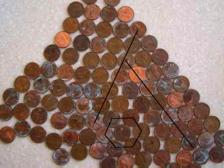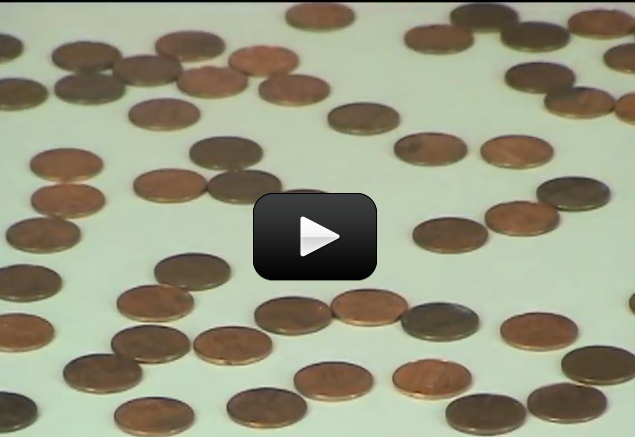 The atoms in a solid, as we mentioned before, are usually held close to one another and tightly together. Imagine a bunch of folks all stuck to one another with glue. Each person can wiggle and jiggle but they can’t really move anywhere.
The atoms in a solid, as we mentioned before, are usually held close to one another and tightly together. Imagine a bunch of folks all stuck to one another with glue. Each person can wiggle and jiggle but they can’t really move anywhere.
Atoms in a solid are the same way. Each atom can wiggle and jiggle but they are stuck together. In science, we say that the molecules have strong bonds between them. Bonds are a way of describing how atoms and molecules are stuck together.
There’s nothing physical that actually holds them together (like a tiny rope or something). Like the Earth and Moon are stuck together by gravity forces, atoms and molecules are held together by nuclear and electromagnetic forces. Since the atoms and molecules come so close together they will often form crystals.
Try this experiment and then we will talk more about this:
Please login or register to read the rest of this content.


I noticed that between each
triangle gap there were
zigzags.
You will substitute salt for the sugar and follow the same recipe as “Laundry Soap” crystals.
how do you make salt crystals? i am a salt lover……
my kids love it! all 4 of them
No, not at this time… which can totally mean that it’s out there and we just haven’t discovered it yet.
That’s a magnetar… I might reword that to say “attract the iron” instead of “suck the iron”, but magnetars are the most powerful magnetized objects (they are magnetized neutron stars) in the universe.
I have another question on BEC. Is it found anywhere in the universe naturally? I thought maybe ice volcanoes on ice moons, dwarf planets, comets, asteroids, asteroid moons, meteorites/meteors or ice planets would have BEC on them.
From, Julian (8)
Wow! I knew there was such a thing called a Neutron Star, but now I know how they are formed. Thanks!
What about a thing thats similar to a Neutron Star that shoots magnetic pulses and can suck the iron out of our blood, Do you know what they are called and how they form?
That’s exactly what happens in a neutron star. When a star runs out of fuel and it’s large enough to collapse down but not massive enough to form a black hole, when it collapses down, it crushes the atoms together so much that the space between the atoms is basically gone, and the negative electrons fuse with the positive protons to form neutral neutrons, and what’s left is a big ball of neutrons (hence the name “neutron star”). The neutrons are packed to tightly together that it’s incredibly dense. For example, if a single strand of hair on your head was made of the same stuff as a neutron star is made out of, that single hair strand would weigh more than the Empire State building.
what happens if you force the atoms(pennies) to be tighter so there is no space between them?
~Julian(8)
A practical application of this fun experiment: We used the knowledge of the shapes formed by the pennies to quickly count our coin collection for coin wrappers. 5 triangles per penny wrapper. Super fast for the visual and geometric seeing person and means you don’t have to count out to 50!
This video also cuts off after 30s. Help!